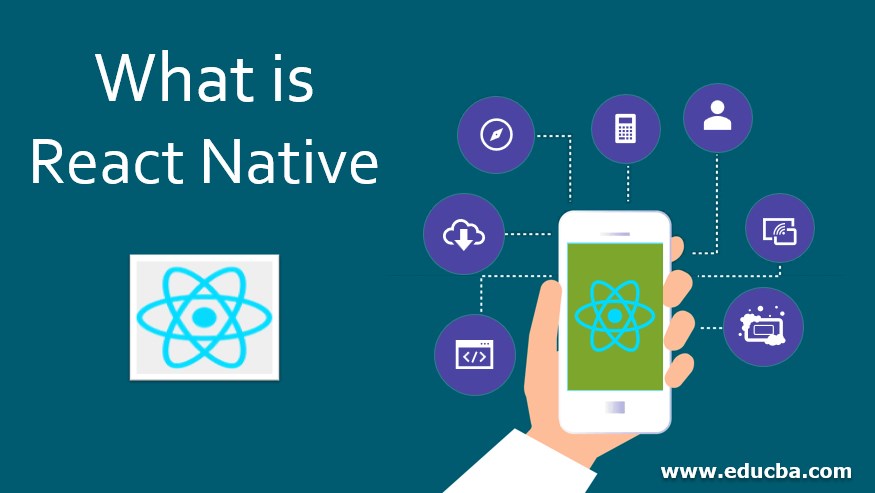Updated June 26, 2023

Introduction to React Native
React Native is a JavaScript framework created by Facebook for writing real mobile applications, primarily for iOS and Android. It comes out of React, Facebook’s JavaScript library for building user interfaces, but mainly focuses on Mobile Platforms. Now web developers can write mobile applications from the comfort of a JavaScript library they already know. Most of the codes can now be shared between platforms; React Native simultaneously makes it easy to develop for Android and iOS. Its applications are written with a combination of JavaScript and JSX. This calls the native rendering APIs in Objective-C (for iOS) or Java (for Android). Unlike the review, the applications will use real mobile UI components. It also supports JavaScript interfaces for platform APIs so that the apps can access platform features like the phone camera or the user’s location.
Reasons to Use React Native
Let’s review some reasons for choosing React Native over other frameworks for developing Mobile Apps.
- Every CEO wants to attain the highest possible efficiency with less effort. React Native helps in using the same code for deployment on both iOS and Android platforms. Businesses become more time and cost-efficient by shortening the development cycle. It can be possible to minimize the development efforts to almost 50% without facing any trade-off between either quality or productivity.
- React Natives uses the ReactJS UI library developed by Facebook for UIs and apps. It transfers Virtual DOM, Better app performance, and easier programming processes from ReactJS. This framework also supports the live reload feature, which is not the case with other native frameworks. Live Reload helps view the latest code changes, and If two screens are opened simultaneously, the first shows the code, while the second shows the result.
- Now a Javascript developer with skills in native UI elements, design patterns, and APIs can quickly develop mobile applications. React Native provides good support from a community of developers. Whenever problems arise, JavaScript and native enthusiasts offer help to fix them.
- It works for mobile UI building. A mobile app built on React Native is smoother and much faster than a classic one.
- Deploying a single code base to multiple mobile operating systems is possible. The code allows for the reuse of components at any level without rewriting them.
- React Native codes are reusable. A single update works for two platforms. It eases bug detection in the codes. The developers can easily understand the project, and even if they were not a part of the project earlier, they can understand the codes and take it as a base to work further. It makes it more flexible and easier to introduce new updates. The work of QA engineers also becomes quite more accessible, and they can complete their tasks in lesser hours with relevant test cases.
- 3rd party plugins can efficiently work even without specific WebView Functions. The framework enables the linking of plugins with the native module. Plugins can be linked with an app smoothly; eventually, it will be faster and less memory will be required.
- The developers are happily adopting it as the Developers are looking to upgrade their skills in such technologies, which won’t get disappeared in a couple of years.
Facebook is also looking ahead for huge investments to help React Native grow in the market.
Advantages
The advantages of using React Native over any other Native Framework are defined below:
- It has a community-driven environment through which one can seek help from native developers and experts over his/her project or any framework-related issue.
- It provides the facility of maximum code reuse, which means one can use the same code to develop mobile applications in Android and iOS. Because of this factor, one can save time and money in application development.
- Compared to other native platforms that are more inclined towards CPU (Central Processing Unit), it is very fast due to its GPU (Graphics Processing Unit) utilization.
- It also offers simplification of the process of data binding, which provides more stability for mobile applications as compared to other native platforms, which makes this a more reliable platform.
- React Native offers huge support for Third-party plugins because these developers get various options, including both JavaScript modules and native.
- It offers a simple user interface because this is commonly known as an open-source JavaScript library instead being a platform.
- It supports Live Reloading and Hot Reloading, which means the developers can see the outcome instantly after making the changes in the code.
With all of the above advantages, we can infer the below benefits of React Native.”
- Better Performance as compared to other Native.
- Reusability of codes
- Cost Efficiency
- Support for Third-Party Plugins
- Strong support from the community
- More stable apps creation than competitors
- Simple and Easy User Interface to work on
- The libraries are more handy to use.
Conclusion
As we can see, React Native being a more popular framework as compared to the other Native frameworks, has been hyped in the Mobile App Development Market, which can help in simplifying and making this industry flourish. It has been a great help in saving time and money by minimizing the efforts and team scaling. With time we have seen that the Apps built on React Native work far more efficiently and agile. Apps run more smoothly, and fast loading speed can be attained with less memory usage. For worst-case scenarios, we can always trust the support of the community. For now, it will stay in the market and help the developers ease their work and develop faster, interactive apps.
Recommended Articles
This is a guide to What is React Native? Here we discuss the introduction, reasons to use React Native, along with the advantages. You can also go through our other related articles to learn more–


